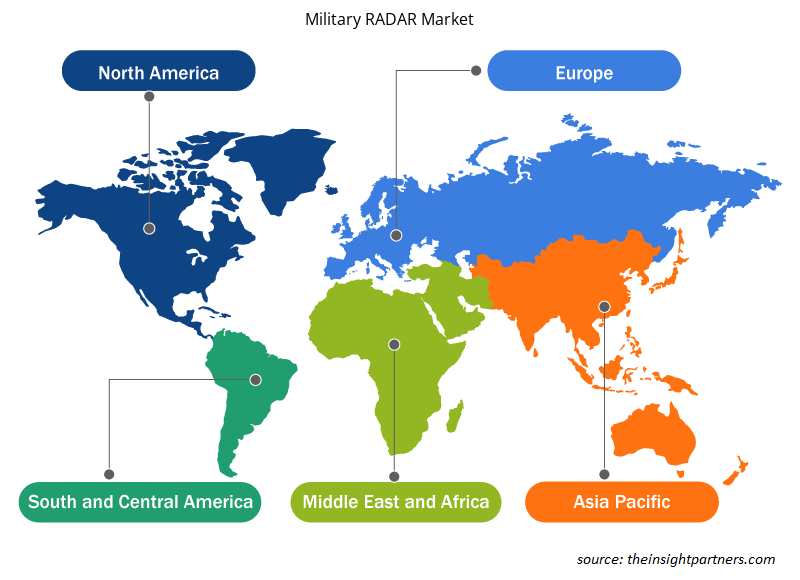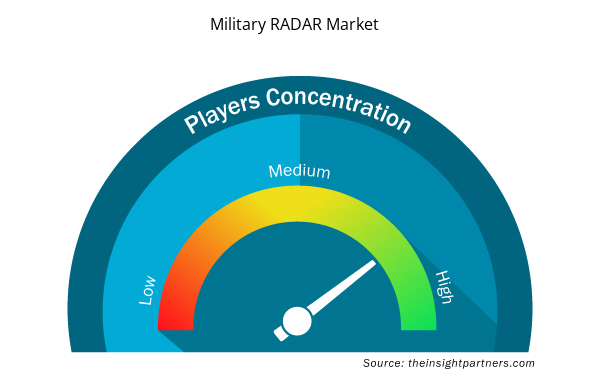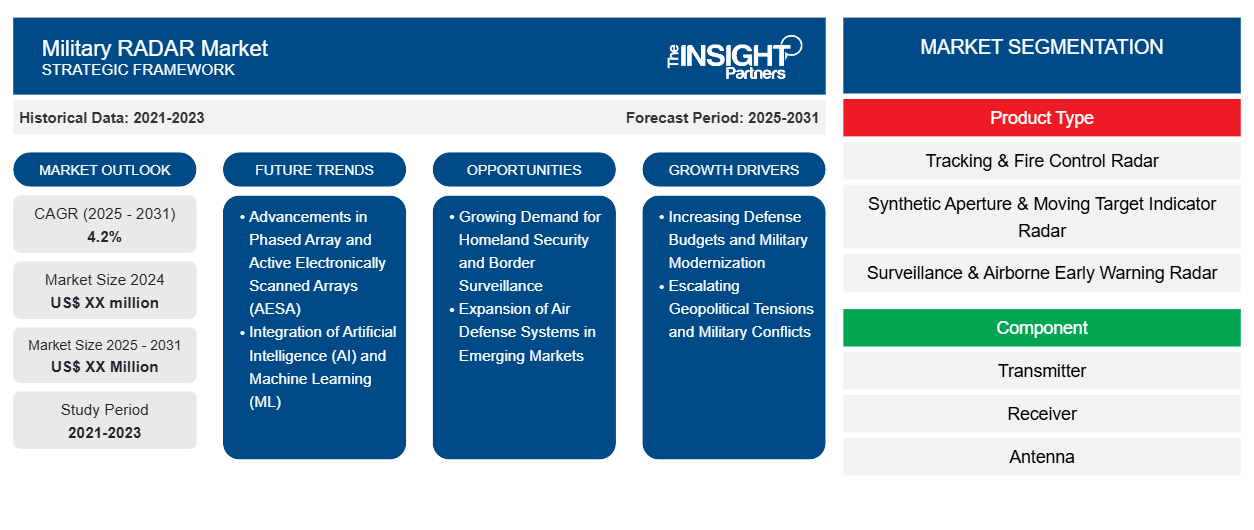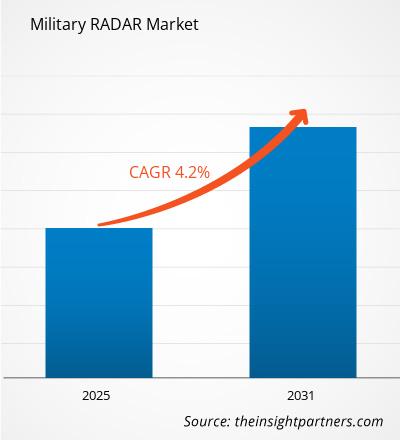Si prevede che il mercato dei radar militari registrerà un CAGR del 4,2% dal 2024 al 2031, con una dimensione di mercato in espansione da XX milioni di dollari nel 2024 a XX milioni di dollari entro il 2031.
Il report è segmentato per tipo di prodotto (radar di tracciamento e controllo del fuoco, radar ad apertura sintetica e indicatore di bersaglio in movimento, radar di sorveglianza e di allerta precoce aerea, radar multifunzione, radar di localizzazione delle armi e radar C-Ram, radar a penetrazione del suolo, altri); componente (trasmettitore, ricevitore, antenna, duplexer, display, altri); piattaforma (radar navale, radar aereo, radar terrestre). L'analisi globale è ulteriormente suddivisa a livello regionale e nei principali paesi. Il report offre il valore in USD per l'analisi e i segmenti di cui sopra.
Scopo del rapporto
Il report Military Radar Market di The Insight Partners mira a descrivere il panorama attuale e la crescita futura, i principali fattori trainanti, le sfide e le opportunità. Ciò fornirà spunti a vari stakeholder aziendali, come:
- Fornitori/produttori di tecnologia: per comprendere le dinamiche di mercato in evoluzione e conoscere le potenziali opportunità di crescita, consentendo loro di prendere decisioni strategiche informate.
- Investitori: condurre un'analisi completa delle tendenze in merito al tasso di crescita del mercato, alle proiezioni finanziarie del mercato e alle opportunità esistenti lungo la catena del valore.
- Enti di regolamentazione: regolamentano le politiche e le attività di controllo sul mercato allo scopo di ridurre al minimo gli abusi, preservare la fiducia degli investitori e sostenere l'integrità e la stabilità del mercato.
Segmentazione del mercato dei radar militari
Tipo di prodotto
- Radar di tracciamento e controllo del fuoco
- Radar indicatore di apertura sintetica e bersaglio mobile
- Sorveglianza e radar di allerta precoce aereo
- Radar multifunzione
- Localizzazione delle armi e radar C-Ram
- Radar a penetrazione del suolo
- Altri
Componente
- Trasmettitore
- Ricevitore
- Antenna
- Duplexer
- Display
- Altri
Piattaforma
- Radar navale
- Radar aereo
- Radar terrestre
Geografia
- America del Nord
- Europa
- Asia-Pacifico
- America del Sud e Centro
- Medio Oriente e Africa
Personalizza questo report in base alle tue esigenze
Riceverai la personalizzazione gratuita di qualsiasi report, comprese parti di questo report, o analisi a livello nazionale, pacchetto dati Excel, oltre a usufruire di grandi offerte e sconti per start-up e università
- Scopri le principali tendenze di mercato in questo rapporto.Questo campione GRATUITO includerà analisi di dati che spaziano dalle tendenze di mercato alle stime e alle previsioni.
Fattori trainanti della crescita del mercato dei radar militari
- Aumento dei budget per la difesa e modernizzazione militare: l'aumento dei budget per la difesa in tutto il mondo, in particolare in regioni come il Nord America, l'Asia-Pacifico e il Medio Oriente, è un fattore trainante importante del mercato dei radar militari. I governi si stanno concentrando sulla modernizzazione delle loro capacità di difesa per contrastare le minacce emergenti, tra cui la difesa missilistica, la sorveglianza e le operazioni antiterrorismo. Poiché le forze militari richiedono sistemi radar avanzati per la difesa aerea, terrestre e marittima, la domanda di tecnologia radar che offra una maggiore portata di rilevamento, precisione e affidabilità è in crescita. Questa tendenza garantisce una costante espansione del mercato poiché i paesi investono in tecnologie radar di nuova generazione per migliorare la sicurezza nazionale e la prontezza operativa.
- Tensioni geopolitiche e conflitti militari in aumento: le crescenti tensioni geopolitiche, le dispute territoriali e i conflitti regionali hanno portato a una domanda crescente di sistemi radar militari avanzati. Questi radar svolgono un ruolo fondamentale nella sorveglianza, nel rilevamento precoce e nel targeting nelle operazioni militari. Poiché minacce come missili balistici, droni e velivoli stealth diventano più sofisticate, le forze militari richiedono sistemi radar in grado di rilevare e neutralizzare queste minacce moderne. Di conseguenza, la domanda globale di tecnologie radar all'avanguardia sta accelerando, con un'enfasi sui sistemi in grado di tracciare più minacce contemporaneamente e fornire consapevolezza della situazione in tempo reale.
Tendenze future del mercato dei radar militari
- Progressi nei sistemi radar Phased Array e Active Electronically Scanned Array (AESA): una tendenza chiave nel mercato dei radar militari è il crescente utilizzo dei sistemi radar Phased Array e Active Electronically Scanned Array (AESA). I radar AESA offrono una scansione più rapida, una risoluzione più elevata e la capacità di tracciare più bersagli contemporaneamente, rendendoli ideali per gli ambienti di combattimento moderni. Questi sistemi radar sono sempre più utilizzati in jet da combattimento, navi militari e sistemi di difesa missilistica. La tendenza verso la tecnologia radar AESA e Phased Array riflette la crescente necessità di soluzioni radar altamente accurate, adattabili e versatili in grado di rilevare un'ampia gamma di minacce in condizioni dinamiche del campo di battaglia.
- Integrazione di intelligenza artificiale (AI) e apprendimento automatico (ML): l'integrazione di intelligenza artificiale (AI) e apprendimento automatico (ML) nei sistemi radar militari sta trasformando il modo in cui i dati radar vengono analizzati e interpretati. Gli algoritmi di AI e ML possono migliorare l'elaborazione del segnale radar, contribuendo a ridurre i falsi allarmi e a migliorare l'identificazione e la classificazione del bersaglio. Queste tecnologie consentono inoltre ai radar di adattarsi automaticamente alle nuove minacce, rendendoli più reattivi in scenari di combattimento in rapida evoluzione. Mentre le forze militari cercano di migliorare la velocità, la precisione e l'efficienza dei loro sistemi radar, l'integrazione di AI e ML sta diventando una tendenza critica che guida l'innovazione nel mercato dei radar militari.
Opportunità di mercato del radar militare
- Crescente domanda di sicurezza nazionale e sorveglianza dei confini: la crescente attenzione alla sicurezza nazionale e alla sorveglianza dei confini presenta significative opportunità per il mercato dei radar militari. I governi stanno investendo in sistemi radar in grado di monitorare vaste aree per attività illegali, come attraversamenti di confine non autorizzati, tratta di esseri umani e contrabbando. I sistemi radar terrestri e aerei dotati di sensori avanzati e analisi dei dati in tempo reale sono essenziali per migliorare la sicurezza dei confini. Mentre le nazioni danno priorità alla protezione dei propri confini, c'è un mercato crescente per i sistemi radar su misura per la sorveglianza e la rilevazione precoce, che guida la domanda sia per nuove installazioni che per aggiornamenti di sistema.
- Espansione dei sistemi di difesa aerea nei mercati emergenti: i mercati emergenti, in particolare in regioni come Medio Oriente, Asia-Pacifico e Africa, stanno aumentando significativamente gli investimenti nei sistemi di difesa aerea, creando opportunità per i produttori di radar militari. Queste regioni stanno cercando di migliorare le loro capacità di difesa aerea per contrastare le crescenti minacce di attacchi missilistici, attacchi con droni e violazioni dello spazio aereo. La domanda di sistemi radar che supportino sistemi di difesa aerea integrati, tra cui il tracciamento e l'intercettazione delle minacce aeree, è destinata ad aumentare. Questa espansione offre alle aziende opportunità di sviluppare soluzioni radar su misura per la sorveglianza aerea, la difesa missilistica e i sistemi di allerta precoce, stimolando ulteriormente la crescita del mercato.
Approfondimenti regionali sul mercato dei radar militari
Le tendenze regionali e i fattori che influenzano il mercato dei radar militari durante il periodo di previsione sono stati ampiamente spiegati dagli analisti di Insight Partners. Questa sezione discute anche i segmenti e la geografia del mercato dei radar militari in Nord America, Europa, Asia Pacifico, Medio Oriente e Africa e America centrale e meridionale.

- Ottieni i dati specifici regionali per il mercato dei radar militari
Ambito del rapporto sul mercato dei radar militari
| Attributo del report | Dettagli |
|---|---|
| Dimensioni del mercato nel 2024 | XX milioni di dollari USA |
| Dimensioni del mercato entro il 2031 | XX milioni di dollari USA |
| CAGR globale (2025 - 2031) | 4,2% |
| Dati storici | 2021-2023 |
| Periodo di previsione | 2025-2031 |
| Segmenti coperti | Per tipo di prodotto
|
| Regioni e Paesi coperti | America del Nord
|
| Leader di mercato e profili aziendali chiave |
|
Densità degli attori del mercato dei radar militari: comprendere il suo impatto sulle dinamiche aziendali
Il mercato del Military RADAR Market sta crescendo rapidamente, spinto dalla crescente domanda degli utenti finali dovuta a fattori quali l'evoluzione delle preferenze dei consumatori, i progressi tecnologici e una maggiore consapevolezza dei vantaggi del prodotto. Con l'aumento della domanda, le aziende stanno ampliando le loro offerte, innovando per soddisfare le esigenze dei consumatori e capitalizzando sulle tendenze emergenti, il che alimenta ulteriormente la crescita del mercato.
La densità degli operatori di mercato si riferisce alla distribuzione di aziende o società che operano in un particolare mercato o settore. Indica quanti concorrenti (operatori di mercato) sono presenti in un dato spazio di mercato in relazione alle sue dimensioni o al valore di mercato totale.
Le principali aziende che operano nel mercato dei radar militari sono:
- La Northrop Grumman
- Sistemi Bae
- Saab AB
- Industrie aerospaziali israeliane
- Gruppo Talete
Disclaimer : le aziende elencate sopra non sono classificate secondo un ordine particolare.

- Ottieni una panoramica dei principali attori del mercato dei radar militari
Punti chiave di vendita
- Copertura completa: il rapporto esamina in modo completo i prodotti, i servizi, le tipologie e gli utenti finali del mercato dei radar militari, fornendo una panoramica olistica.
- Analisi degli esperti: il rapporto è compilato sulla base della conoscenza approfondita di esperti e analisti del settore.
- Informazioni aggiornate: il rapporto garantisce la pertinenza aziendale grazie alla copertura di informazioni recenti e tendenze nei dati.
- Opzioni di personalizzazione: questo report può essere personalizzato per soddisfare le esigenze specifiche del cliente e adattarsi in modo appropriato alle strategie aziendali.
Il rapporto di ricerca sul Military Radar Market può, quindi, aiutare a guidare il percorso di decodifica e comprensione dello scenario del settore e delle prospettive di crescita. Sebbene possano esserci alcune preoccupazioni valide, i vantaggi complessivi di questo rapporto tendono a superare gli svantaggi.
- Analisi storica (2 anni), anno base, previsione (7 anni) con CAGR
- Analisi PEST e SWOT
- Valore/volume delle dimensioni del mercato - Globale, regionale, nazionale
- Industria e panorama competitivo
- Set di dati Excel



Report Coverage
Revenue forecast, Company Analysis, Industry landscape, Growth factors, and Trends

Segment Covered
This text is related
to segments covered.

Regional Scope
North America, Europe, Asia Pacific, Middle East & Africa, South & Central America

Country Scope
This text is related
to country scope.
Domande frequenti
Some of the customization options available based on request are additional 3-5 company profiles and country-specific analysis of 3-5 countries of your choice. Customizations are to be requested/discussed before making final order confirmation, as our team would review the same and check the feasibility.
The report can be delivered in PDF/PPT format; we can also share excel dataset based on the request.
The major factors driving the military radar market are:
1. Deployment of Electronic Warfare Systems
2. Demand for Border Security & Surveillance
Some of the major trends driving the military radar market are:
1. Rising Procurements of Tanks & Aircraft
The Military Radar Market is estimated to witness a CAGR of 4.2% from 2023 to 2031
Trends and growth analysis reports related to Aerospace and Defense : READ MORE..
1. Northrop Grumman
2. Bae Systems
3. Saab A.B.
4. Israel Aerospace Industries
5. Thales Group
6. Raytheon Technologies
7. Leonardo S.p.A.
8. L3Harris Corporation
9. ASELSAN A.S.
10. Hensoldt
The Insight Partners performs research in 4 major stages: Data Collection & Secondary Research, Primary Research, Data Analysis and Data Triangulation & Final Review.
- Data Collection and Secondary Research:
As a market research and consulting firm operating from a decade, we have published and advised several client across the globe. First step for any study will start with an assessment of currently available data and insights from existing reports. Further, historical and current market information is collected from Investor Presentations, Annual Reports, SEC Filings, etc., and other information related to company’s performance and market positioning are gathered from Paid Databases (Factiva, Hoovers, and Reuters) and various other publications available in public domain.
Several associations trade associates, technical forums, institutes, societies and organization are accessed to gain technical as well as market related insights through their publications such as research papers, blogs and press releases related to the studies are referred to get cues about the market. Further, white papers, journals, magazines, and other news articles published in last 3 years are scrutinized and analyzed to understand the current market trends.
- Primary Research:
The primarily interview analysis comprise of data obtained from industry participants interview and answers to survey questions gathered by in-house primary team.
For primary research, interviews are conducted with industry experts/CEOs/Marketing Managers/VPs/Subject Matter Experts from both demand and supply side to get a 360-degree view of the market. The primary team conducts several interviews based on the complexity of the markets to understand the various market trends and dynamics which makes research more credible and precise.
A typical research interview fulfils the following functions:
- Provides first-hand information on the market size, market trends, growth trends, competitive landscape, and outlook
- Validates and strengthens in-house secondary research findings
- Develops the analysis team’s expertise and market understanding
Primary research involves email interactions and telephone interviews for each market, category, segment, and sub-segment across geographies. The participants who typically take part in such a process include, but are not limited to:
- Industry participants: VPs, business development managers, market intelligence managers and national sales managers
- Outside experts: Valuation experts, research analysts and key opinion leaders specializing in the electronics and semiconductor industry.
Below is the breakup of our primary respondents by company, designation, and region:

Once we receive the confirmation from primary research sources or primary respondents, we finalize the base year market estimation and forecast the data as per the macroeconomic and microeconomic factors assessed during data collection.
- Data Analysis:
Once data is validated through both secondary as well as primary respondents, we finalize the market estimations by hypothesis formulation and factor analysis at regional and country level.
- Macro-Economic Factor Analysis:
We analyse macroeconomic indicators such the gross domestic product (GDP), increase in the demand for goods and services across industries, technological advancement, regional economic growth, governmental policies, the influence of COVID-19, PEST analysis, and other aspects. This analysis aids in setting benchmarks for various nations/regions and approximating market splits. Additionally, the general trend of the aforementioned components aid in determining the market's development possibilities.
- Country Level Data:
Various factors that are especially aligned to the country are taken into account to determine the market size for a certain area and country, including the presence of vendors, such as headquarters and offices, the country's GDP, demand patterns, and industry growth. To comprehend the market dynamics for the nation, a number of growth variables, inhibitors, application areas, and current market trends are researched. The aforementioned elements aid in determining the country's overall market's growth potential.
- Company Profile:
The “Table of Contents” is formulated by listing and analyzing more than 25 - 30 companies operating in the market ecosystem across geographies. However, we profile only 10 companies as a standard practice in our syndicate reports. These 10 companies comprise leading, emerging, and regional players. Nonetheless, our analysis is not restricted to the 10 listed companies, we also analyze other companies present in the market to develop a holistic view and understand the prevailing trends. The “Company Profiles” section in the report covers key facts, business description, products & services, financial information, SWOT analysis, and key developments. The financial information presented is extracted from the annual reports and official documents of the publicly listed companies. Upon collecting the information for the sections of respective companies, we verify them via various primary sources and then compile the data in respective company profiles. The company level information helps us in deriving the base number as well as in forecasting the market size.
- Developing Base Number:
Aggregation of sales statistics (2020-2022) and macro-economic factor, and other secondary and primary research insights are utilized to arrive at base number and related market shares for 2022. The data gaps are identified in this step and relevant market data is analyzed, collected from paid primary interviews or databases. On finalizing the base year market size, forecasts are developed on the basis of macro-economic, industry and market growth factors and company level analysis.
- Data Triangulation and Final Review:
The market findings and base year market size calculations are validated from supply as well as demand side. Demand side validations are based on macro-economic factor analysis and benchmarks for respective regions and countries. In case of supply side validations, revenues of major companies are estimated (in case not available) based on industry benchmark, approximate number of employees, product portfolio, and primary interviews revenues are gathered. Further revenue from target product/service segment is assessed to avoid overshooting of market statistics. In case of heavy deviations between supply and demand side values, all thes steps are repeated to achieve synchronization.
We follow an iterative model, wherein we share our research findings with Subject Matter Experts (SME’s) and Key Opinion Leaders (KOLs) until consensus view of the market is not formulated – this model negates any drastic deviation in the opinions of experts. Only validated and universally acceptable research findings are quoted in our reports.
We have important check points that we use to validate our research findings – which we call – data triangulation, where we validate the information, we generate from secondary sources with primary interviews and then we re-validate with our internal data bases and Subject matter experts. This comprehensive model enables us to deliver high quality, reliable data in shortest possible time.


 Ottieni un campione gratuito per questo repot
Ottieni un campione gratuito per questo repot